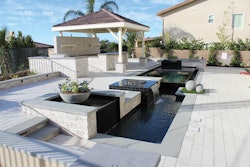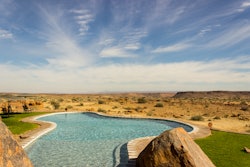
As drought conditions worsen across the southwestern United States, municipalities are feeling the heat. Under the pressure of dwindling water supplies, local governments have been tightening water use restrictions — a growing number of which directly regulate swimming pools.
Southern Nevada is a case in point. Lake Mead — the area’s primary water source, fed by the drought-stricken Colorado River Basin — fell below 30% capacity this summer, its lowest since 1937. The situation has become so dire that the feds declared an official water shortage, sparking cuts that reduce Southern Nevada’s water allocation by almost 7 billion gallons.
As the driest metropolitan area in the country, residential areas in the Las Vegas Valley have followed a progressive conservation program for decades. But with no relief in sight, additional, stricter measures are on the horizon — the latest of which limits the size of home swimming pools.
WHAT HAPPENED IN VEGAS
On July 21, 2022, the Southern Nevada Water Authority Board of Directors met to discuss, among other items, enacting a size limit of 600 square feet of total combined surface area for single-family residential pools, spas and water features. A resolution in the meeting agenda asserted that this pool size limit would “reduce wasteful development practices and water consumption due to evaporation.”
The SNWA’s 2021 Water Resource Plan foreshadowed this proposal to some extent, outlining an objective to “implement pool development standards” among 13 other focus areas for water conservation. The pool size limit was projected to reduce water usage by 0.1 gallons per capita per day, making it the least influential measure in the overall Resource Plan.
According to water authority General Manager John Entsminger, 75% of recently constructed pools in the area already fit within the proposed limit.
“We have a lot of pools that exceed 3,000 square feet…and a lot of [the features] are not even used for recreation. It’s all aesthetic,” he said in the meeting. “The increase in ‘poolscaping’ definitely threatens to erode our efficiency gains in conservation.”
After initially hearing about the proposed size limit, local pool builder Terry Mayfield, director of PHTA’s Southern Nevada Chapter, says he and fellow industry pros were not surprised. “We didn’t disagree with the idea, but we didn’t agree with the 600 square foot number,” he explains. “So we met with the SNWA on two or three occasions and expressed our support for what they were trying to do, but advised them that we thought the number should be different.”
“It would’ve been a lot better had they come to us and said, ‘Listen, we need to put together a conservation effort with regard to swimming pools, what do you think? What would be the best way to approach this?’” says Joe Vassallo of Paragon Pools. “Instead, they just came up with that number... as far as I can tell, to be perfectly honest, you could have just thrown a dart at a dart board. It doesn’t make sense at all.”
With assistance from PHTA’s Nevada Chapter, Mayfield, Vassallo and others banded together to present an alternative proposal, based on analysis by Shawn McCoy, Ph.D. That proposal would limit pool construction to 7% of total lot size, with a cap at 1,000 square feet. Any pools exceeding that number would be subject to conservation fees, with the absolute maximum pool size being 2,940 square feet. Size and conservation fee exemptions would be granted for pools with permanently installed automatic pool covers.
“We wanted to be part of the solution to the drought issue,” adds Vassallo. “We made a proposal that would have some restrictions, but would have been a little better for us and for the community, especially for those people that had a higher-end home with a big lot. And the numbers clearly showed we had a better proposal that would even save more water in the long run.” But during the meeting, board members alleged that there were flaws in the pool industry’s data analysis, and that it would save less water than projected.
Ultimately, the Clark County Commission proceeded to vote 6-0 in favor of the 600-square-foot size limit. The water district can enforce the restriction on any new pools at single-family residences that obtain permits after September 1.
“We felt like they listened to us, but it didn’t matter what we said. They were going to go with what they came up with,” says Vassallo. “I applaud the SNWA’s efforts — I will tell you, they’ve done a fantastic job with water conservation. But I think at least this part with the pools is a step too far.”
RUNNING THE NUMBERS
There are an estimated 200,000 residential swimming pools in Southern Nevada, with 1,300 new ones built each year, according to Entsminger.
The average size of these pools is 470 square feet. The average 470-square-foot pool in the area, he adds, loses 23,000 gallons of water annually due to evaporation.
As the industry knows, such water loss can be mitigated simply by using a pool cover. In general, studies have shown that pool cover use reduces evaporation up to 95%.
Now, there are many variables at play here. As the EPA says, a range of factors complicate calculating water savings from a pool cover, including pool cover type, material grade, pool size and shape, local conditions and especially user behavior.
But for what it’s worth: If even 75% of those 1,300 new pools in Southern Nevada used a pool cover, approximately 21.3 million gallons of water could be saved over the course of a single year.
By comparison, the SNWA’s new size limit will save an average of 3.2 million gallons per year.
“What these communities don’t realize is that there’s a way to have your cake and eat it too — essentially, by using a pool cover,” says Graham Orme, product manager of Fluidra Specialty Products. Cover-Pools, a subsidiary of Fluidra, manufactures automatic safety pool covers.
“They think that limiting pool size will stop water loss. But even if you have a 600-square-foot pool, if you don’t cover it, you’re going to continue losing water,” he adds. “If they were to require a cover on each of these pools instead, customers wouldn’t have to be limited to pool size, and they would be further reaching their goal.”
At one time, the SNWA offered homeowners a rebate for purchasing a pool cover. According to a representative, that rebate incentivized the purchase of more than 45,000 covers, saving an estimated 5.6 billion gallons of water during the 15 or so years it was in place.
Comparatively, the new pool size limit is projected to save 32 million gallons over 10 years.
The SNWA’s pool cover rebate was discontinued sometime last year. “Having achieved its primary goal of increasing the number of pool owners capitalizing on the water and energy savings provided by covers, the program met its objective,” the SNWA stated, adding that “the well of opportunity has diminished through the success of prior efforts.”
The SNWA still encourages homeowners to use pool covers to aid conservation, but they are not required. In fact, legislation requiring pool covers doesn’t really exist anywhere — at least not yet. At most, some areas include pool cover requirements in certain “stages” or “phases” of water restriction plans.
“I wouldn’t be surprised if it never happens, but currently, nothing is in place, to my knowledge,” says Jon Damaska, director and general manager of specialty and spa at Fluidra. “But it’s definitely being talked about.”
It must be noted that these are merely fractions of the 91 billion gallons the region draws from Lake Mead every year. All water-saving measures are important, of course, and contribute to the end goal — but some drops are larger than others.
JUST THE BEGINNING
Contrary to the old adage, what happened in Vegas probably won’t stay in Vegas. Already, nearby Boulder City voted to adopt the same pool size ordinance, and as the drought continues, these types of restrictions are likely to spread.
PHTA’s ‘Let’s Pool Together’ campaign has worked for years to dispel misinformation and help defend the pool and spa industry from drought-related water restrictions. It was initially focused on California, but as the situation worsens across the country, efforts have expanded to additional states impacted by drought.
“Pools and spas are mistakenly represented as water wasters, when in fact, they’re water savers. We, as an industry, are water conservationists,” says Jason Davidson, director of government relations at PHTA. He helps take the lead on legislative and regulatory issues while facilitating grassroots involvement, which is crucial in cases like this.
“Grassroot efforts involve PHTA members, builders and service people of the industry coming together and talking with their local government leaders and state leaders,” he says. “They’re the ones that are on the ground in those states and cities, and they’re the most effective because they live in those communities and elect representatives.”
“Oftentimes, there’s only 24 to 48 hours of notice before a city council votes on something like this,” adds Allison Pimm, associate vice president at Vault Communications, who works on the Let’s Pool Together campaign. “There’s not always a ton of advanced notice…This could very well happen at the next meeting in some communities. [Industry members] need to be aware of that, and keep their eyes and ears open to see if they can get there and be that local presence.”
“These types of [restrictions] might sound good on paper…But when it comes to looking someone in the face and telling them how they’re going to do something that impacts their livelihood, that’s where we see the biggest impact.”
For talking points, a draft letter to city officials and other resources, visit www.letspooltogether.com.






































